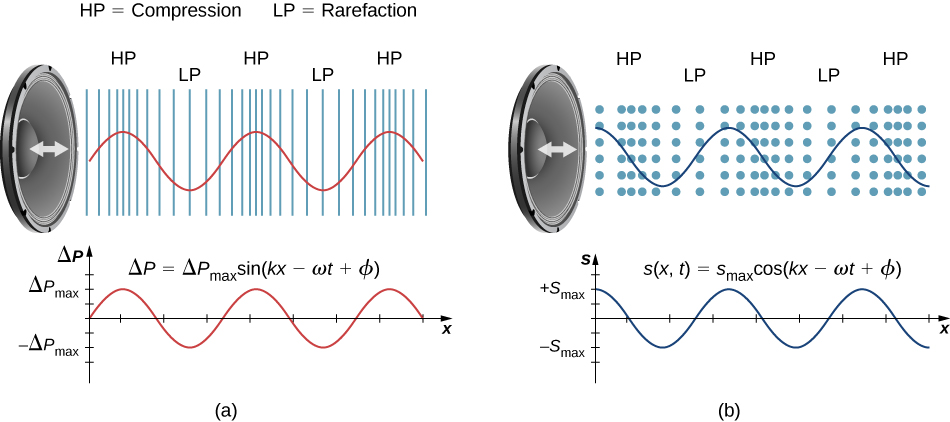The Mechanics of Hearing
39
Learning Objectives
Be able to describe at least 3 uses of sound.
Understand what sound waves are (pressure changes).
Know the relationship between everyday sound waves and atmospheric pressure (unit in Pascal).
The physical phenomenon of sound is a disturbance of matter that is transmitted from its source outward. Hearing is the perception of sound, just as seeing is the perception of visible light. On the atomic scale, sound is a disturbance of atoms that is far more ordered than their thermal motions. In many instances, sound is a periodic wave, and the atoms undergo simple harmonic motion. Thus, sound waves can induce oscillations and resonance effects.
For example, a speaker produces a sound wave by oscillating a cone, causing vibrations of air molecules. It vibrates at a constant frequency and amplitude, producing vibrations in the surrounding air molecules. As the speaker oscillates back and forth, it transfers energy to the air, mostly as thermal energy. But a small part of the speaker’s energy goes into compressing and expanding the surrounding air, creating slightly higher and lower local pressures. These compressions (high-pressure regions) and rarefactions (low-pressure regions) move out as longitudinal pressure waves having the same frequency as the speaker—they are the disturbance that is a sound wave. (Sound waves in air and most fluids are longitudinal, because fluids have almost no shear strength. In solids, sound waves can be both transverse and longitudinal.)

Sound waves are pressure changes, usually in air. Compression and rarefaction describe the regions of high and low pressure, respectively, that form when something vibrates and starts a sound wave. The pressure changes propagate (travel) at a rate of 340 m/s (1100 ft/s) in air; 1500 m/s in water.

The Pascal is the standard unit for pressure (force per area); for reference atmospheric pressure (at sea level) is 101 kPa. An express subway train generates pressures of ~2 Pa, and conversational speech generates sound waves with intensities of approximately 20 millipascals (mPa). So the sounds we hear are tiny modulations of the air pressure.
Now how do we interpret these pressure waves? Our auditory system converts pressure waves into meaningful sounds. This translates into our ability to locate sounds in nature, to appreciate the beauty of music, and to communicate with one another through spoken language.
CC LICENSED CONTENT, SHARED PREVIOUSLY
OpenStax University Physics Volume 1 Section 17.1 Sound Waves
Provided by: Rice University.
Access for free at https://openstax.org/books/university-physics-volume-1/pages/1-introduction
License: CC BY 4.0
OpenStax, Psychology Chapter 5.2 Waves and Wavelengths
Provided by: Rice University.
Download for free at: https://cnx.org/contents/Sr8Ev5Og@12.2:K-DZ-03P@12/5-1-Sensation-versus-Perception.
License: Creative Commons Attribution 4.0
Cheryl Olman PSY 3031 Detailed Outline
Provided by: University of Minnesota
Download for free at http://vision.psych.umn.edu/users/caolman/courses/PSY3031/
License of original source: CC Attribution 4.0

